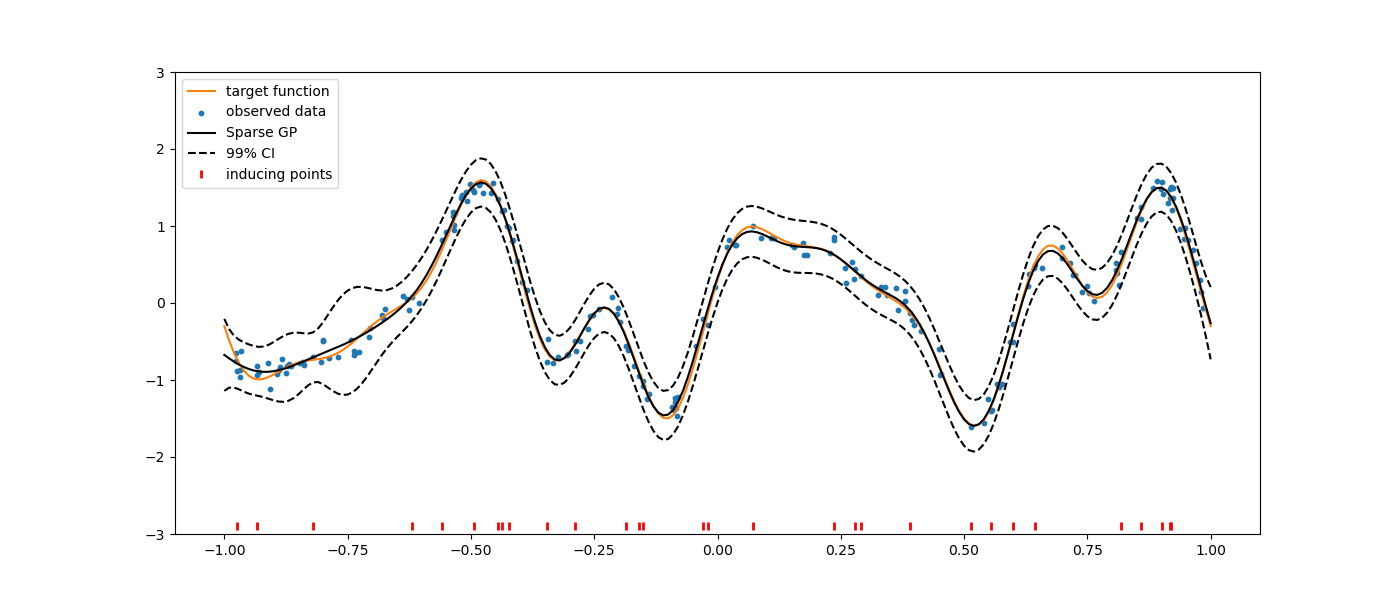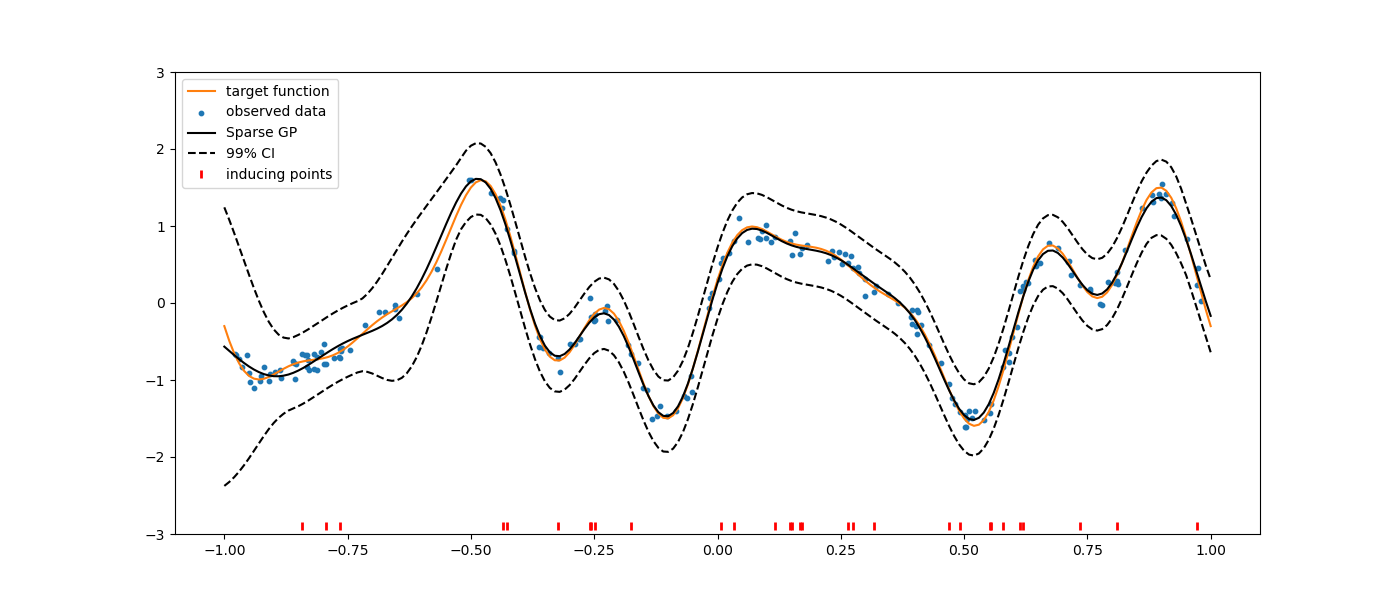Sparse Gaussian Process (SGP)¶
Although the versatility of Gaussian Process regression models for learning complex data, their computational complexity, which is \(\mathcal{O}(N^3)\) with \(N\) the number of training points, prevent their use to large datasets. This complexity results from the inversion of the covariance matrix \(\mathbf{K}\). We must also highlight that the memory cost of GPR models is \(\mathcal{O}(N^2)\), mainly due to the storage of the covariance matrix itself.
To address these limitations, sparse GPs approximation methods have emerged as efficient alternatives. Sparse GPs consider a set of inducing points to approximate the posterior Gaussian distribution with a low-rank representation, while the variational inference provides a framework for approximating the posterior distribution directly. Thus, these methods enable accurate modeling of large datasets while preserving computational efficiency (typically \(\mathcal{O}(NM^2)\) time and \(\mathcal{O}(NM)\) memory for some chosen \(M<N\)).
See [1] for a detailed information and discussion on several approximation methods benefits and drawbacks.
Implementation¶
In SMT the methods: Fully Independent Training Conditional (FITC) method and the Variational Free Energy (VFE) approximation are implemented inspired from inference methods developed in the GPy project [2]
In practice, the implementation relies on the expression of their respective negative marginal log likelihood (NMLL), which is minimised to train the methods. We have the following expressions:
For FITC
For VFE
where
and \(\eta^2\) is the variance of the gaussian noise assumed on training data.
Limitations¶
Inducing points location can not be optimized (a workaround is to provide inducing points as the centroids of k-means clusters over the training data).
Trend function is assumed to be zero.
Usage¶
Using FITC method¶
import numpy as np
import matplotlib.pyplot as plt
from smt.surrogate_models import SGP
def f_obj(x):
import numpy as np
return (
np.sin(3 * np.pi * x)
+ 0.3 * np.cos(9 * np.pi * x)
+ 0.5 * np.sin(7 * np.pi * x)
)
# random generator for reproducibility
rng = np.random.RandomState(0)
# Generate training data
nt = 200
# Variance of the gaussian noise on our trainingg data
eta2 = [0.01]
gaussian_noise = rng.normal(loc=0.0, scale=np.sqrt(eta2), size=(nt, 1))
xt = 2 * rng.rand(nt, 1) - 1
yt = f_obj(xt) + gaussian_noise
# Pick inducing points randomly in training data
n_inducing = 30
random_idx = rng.permutation(nt)[:n_inducing]
Z = xt[random_idx].copy()
sgp = SGP()
sgp.set_training_values(xt, yt)
sgp.set_inducing_inputs(Z=Z)
# sgp.set_inducing_inputs() # When Z not specified n_inducing points are picked randomly in traing data
sgp.train()
x = np.linspace(-1, 1, nt + 1).reshape(-1, 1)
y = f_obj(x)
hat_y = sgp.predict_values(x)
var = sgp.predict_variances(x)
# plot prediction
plt.figure(figsize=(14, 6))
plt.plot(x, y, "C1-", label="target function")
plt.scatter(xt, yt, marker="o", s=10, label="observed data")
plt.plot(x, hat_y, "k-", label="Sparse GP")
plt.plot(x, hat_y - 3 * np.sqrt(var), "k--")
plt.plot(x, hat_y + 3 * np.sqrt(var), "k--", label="99% CI")
plt.plot(Z, -2.9 * np.ones_like(Z), "r|", mew=2, label="inducing points")
plt.ylim([-3, 3])
plt.legend(loc=0)
plt.show()
___________________________________________________________________________
SGP
___________________________________________________________________________
Problem size
# training points. : 200
___________________________________________________________________________
Training
Training ...
Training - done. Time (sec): 0.1044381
___________________________________________________________________________
Evaluation
# eval points. : 201
Predicting ...
Predicting - done. Time (sec): 0.0001109
Prediction time/pt. (sec) : 0.0000006

Using VFE method¶
import numpy as np
import matplotlib.pyplot as plt
from smt.surrogate_models import SGP
def f_obj(x):
import numpy as np
return (
np.sin(3 * np.pi * x)
+ 0.3 * np.cos(9 * np.pi * x)
+ 0.5 * np.sin(7 * np.pi * x)
)
# random generator for reproducibility
rng = np.random.RandomState(42)
# Generate training data
nt = 200
# Variance of the gaussian noise on our training data
eta2 = [0.01]
gaussian_noise = rng.normal(loc=0.0, scale=np.sqrt(eta2), size=(nt, 1))
xt = 2 * rng.rand(nt, 1) - 1
yt = f_obj(xt) + gaussian_noise
# Pick inducing points randomly in training data
n_inducing = 30
random_idx = rng.permutation(nt)[:n_inducing]
Z = xt[random_idx].copy()
sgp = SGP(method="VFE")
sgp.set_training_values(xt, yt)
sgp.set_inducing_inputs(Z=Z)
sgp.train()
x = np.linspace(-1, 1, nt + 1).reshape(-1, 1)
y = f_obj(x)
hat_y = sgp.predict_values(x)
var = sgp.predict_variances(x)
# plot prediction
plt.figure(figsize=(14, 6))
plt.plot(x, y, "C1-", label="target function")
plt.scatter(xt, yt, marker="o", s=10, label="observed data")
plt.plot(x, hat_y, "k-", label="Sparse GP")
plt.plot(x, hat_y - 3 * np.sqrt(var), "k--")
plt.plot(x, hat_y + 3 * np.sqrt(var), "k--", label="99% CI")
plt.plot(Z, -2.9 * np.ones_like(Z), "r|", mew=2, label="inducing points")
plt.ylim([-3, 3])
plt.legend(loc=0)
plt.show()
___________________________________________________________________________
SGP
___________________________________________________________________________
Problem size
# training points. : 200
___________________________________________________________________________
Training
Training ...
Training - done. Time (sec): 0.0890281
___________________________________________________________________________
Evaluation
# eval points. : 201
Predicting ...
Predicting - done. Time (sec): 0.0001070
Prediction time/pt. (sec) : 0.0000005

Options¶
Option |
Default |
Acceptable values |
Acceptable types |
Description |
|---|---|---|---|---|
print_global |
True |
None |
[‘bool’] |
Global print toggle. If False, all printing is suppressed |
print_training |
True |
None |
[‘bool’] |
Whether to print training information |
print_prediction |
True |
None |
[‘bool’] |
Whether to print prediction information |
print_problem |
True |
None |
[‘bool’] |
Whether to print problem information |
print_solver |
True |
None |
[‘bool’] |
Whether to print solver information |
poly |
constant |
[‘constant’] |
[‘str’] |
Regression function type |
corr |
squar_exp |
[‘squar_exp’] |
[‘str’] |
Correlation function type |
pow_exp_power |
1.9 |
None |
[‘float’] |
Power for the pow_exp kernel function (valid values in (0.0, 2.0]), This option is set automatically when corr option is squar, abs, or matern. |
categorical_kernel |
MixIntKernelType.CONT_RELAX |
[<MixIntKernelType.CONT_RELAX: ‘CONT_RELAX’>, <MixIntKernelType.GOWER: ‘GOWER’>, <MixIntKernelType.EXP_HOMO_HSPHERE: ‘EXP_HOMO_HSPHERE’>, <MixIntKernelType.HOMO_HSPHERE: ‘HOMO_HSPHERE’>, <MixIntKernelType.COMPOUND_SYMMETRY: ‘COMPOUND_SYMMETRY’>] |
None |
The kernel to use for categorical inputs. Only for non continuous Kriging |
hierarchical_kernel |
MixHrcKernelType.ALG_KERNEL |
[<MixHrcKernelType.ALG_KERNEL: ‘ALG_KERNEL’>, <MixHrcKernelType.ARC_KERNEL: ‘ARC_KERNEL’>] |
None |
The kernel to use for mixed hierarchical inputs. Only for non continuous Kriging |
nugget |
2.220446049250313e-13 |
None |
[‘float’] |
a jitter for numerical stability |
theta0 |
[0.01] |
None |
[‘list’, ‘ndarray’] |
Initial hyperparameters |
theta_bounds |
[1e-06, 100.0] |
None |
[‘list’, ‘ndarray’] |
bounds for hyperparameters |
hyper_opt |
Cobyla |
[‘Cobyla’] |
[‘str’] |
Optimiser for hyperparameters optimisation |
eval_noise |
True |
[True, False] |
[‘bool’] |
Noise is always evaluated |
noise0 |
[0.01] |
None |
[‘list’, ‘ndarray’] |
Gaussian noise on observed training data |
noise_bounds |
[2.220446049250313e-14, 10000000000.0] |
None |
[‘list’, ‘ndarray’] |
bounds for noise hyperparameters |
use_het_noise |
False |
[True, False] |
[‘bool’] |
heteroscedastic noise evaluation flag |
n_start |
10 |
None |
[‘int’] |
number of optimizer runs (multistart method) |
xlimits |
None |
None |
[‘list’, ‘ndarray’] |
definition of a design space of float (continuous) variables: array-like of size nx x 2 (lower, upper bounds) |
design_space |
None |
None |
[‘BaseDesignSpace’, ‘list’, ‘ndarray’] |
definition of the (hierarchical) design space: use smt.utils.design_space.DesignSpace as the main API. Also accepts list of float variable bounds |
random_state |
41 |
None |
[‘NoneType’, ‘int’, ‘RandomState’] |
Numpy RandomState object or seed number which controls random draws for internal optim (set by default to get reproductibility) |
method |
FITC |
[‘FITC’, ‘VFE’] |
[‘str’] |
Method used by sparse GP model |
n_inducing |
10 |
None |
[‘int’] |
Number of inducing inputs |
